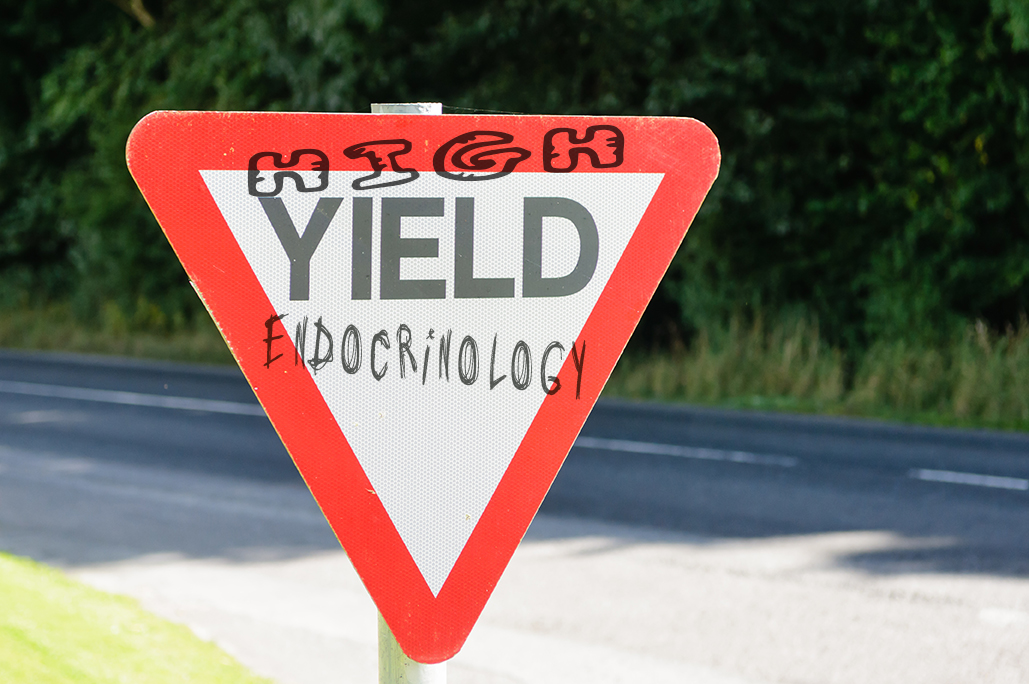Now, That’s What I Call High Yield: Endocrinology
- by
- Feb 27, 2019
- Reviewed by: Amy Rontal, MD

At first, the endocrine system doesn’t come across as a super important one. Without a big sexy organ (like a heart, brain, or lungs) to rally behind, it is everywhere and nowhere at the same time. However, inside your body, hormones keep the train moving. The health of your patients depends on such an exquisite balance of hormones that are easy to take for granted. That is, until they get out of balance, and we suffer the effects.
A knowledge of normal endocrine system functioning is essential and will pave the way for a much easier understanding of what is abnormal. Let’s take a look at the highest-yield concepts in the endocrine system.
Feedback inhibition (10) – This concept is above all else in endocrine, and lays the framework for keeping hormone levels in balance. At its simplest level, if A induces production of B, then having a lot of B will stop A from being produced. For example, thyroid stimulating hormone (TSH) leads to production of T3 and T4, temper further production of TSH. Many of these hormone pathways function on more than two levels, but the basics stay the same.
Adrenals & Adrenal insufficiency (7.5) – The adrenals pump out some crucial products that no one should be without. Know what substances are produced by what layer. Your best bet is to remember GFR, an acronym that belongs to the organ just beneath, the kidneys! Next, write ACAC alongside that. On the left are your layers, and on the right are the products of them:
Glomerulosa Aldosterone
Fasiculata Cortisol
Reticularis Androgens (DHEA)
(Medulla) Catecholamines
When the adrenals stop working, you can lose the function of all of these crucial hormone classes. Without aldosterone, your blood pressure will suffer, Na goes down, K goes up. Without cortisol, blood pressure will suffer, and hypoglycemia will ensue. The lack of catecholamines can also lead to low blood pressure, and missing any and all of the above will lead to a deep sense of fatigue. If you suspect adrenal insufficiency based on H&P and lab values, definitely consider autoimmune disease and tuberculosis at the top of your list.
A factoid worth mentioning – lack of cortisol leads to an increase of the hormone POMC (pro-opiomelanocortin). This protein is cleaved to form endogenous OPIOids, MELANin, and CORTIcotropin, or ACTH (which stimulates cortisol production). The melanin leads to skin darkening, and that’s why adrenal insufficiency can cause hyperpigmentation! How cool is that?
HP-X axis (8) The hypothalamic-pituitary-[insert target organ here] axis is the quintessential model of feedback inhibition. The hypothalamus tells the pituitary to do something, and the pituitary routes the message down the line to the thyroid, or kidneys, or ovaries, etc. Get familiar with all of the hormones that are produced by the hypothalamus and pituitary, and their effects on their end organs. Spend some time doing what it takes to understand all the feedback inhibition between the three levels, and you will be able to explain what’s happening with any deficiency or overproduction state.
Congenital Adrenal Hyperplasia (7) – One of the more painful disease process to understand. Do you need to internalize the 16 precursor molecules to aldosterone, glucocorticoids, and androgens? No. But you do have to know how enzyme deficiencies along the way lead to over- and under-production of the desired hormones. The key tenet is this: if an enzyme is missing that is necessary to create one of the key compounds above, then there will be OVER-production of the other compounds. More on this in a future post.
Cortisol & Cushing’s syndrome (9) – Cortisol is a most important hormone, both in pop science and on Step 1. It is a stress hormone that leads to increased blood pressure, and increased blood glucose. It also has a potent anti-inflammatory and anti-immune effects. This is the reason that cortisol analogues like prednisone are the mainstays of therapy for autoimmune disease.
Too much cortisol for too long leads to Cushing’s syndrome, which is usually iatrogenic in nature, caused by large long-term doses of exogenous steroids. The syndrome is often seen in patients taking steroids for cancer treatment or for autoimmune diseases. The disease can also present in patients who have lost their internal feedback mechanisms and are over-producing cortisol, whether through a cortisol secreting tumor, or an ACTH secreting tumor.
A subtle distinction between Cushing’s syndrome and Cushing’s disease. The syndrome, like any syndrome, is a group of symptoms that occur together (i.e., buffalo hump, moon facies, abdominal striae, poor wound healing). Cushing’s disease is a specific etiology of Cushing’s syndrome—it refers to an ACTH-secreting pituitary tumor in the brain. Recall, Harvey Cushing was the father of neurosurgery, so his “disease” is the intracranial variety.
Parathyroid hormone (7) – Another opportunity for the study medicine to make things difficult for us. The name “parathyroid hormone” tells us nothing about what it does; merely that it comes from a gland near the thyroid. It could just as well be called calcemic hormone, as it puts calcium into the blood. To do so, it steals it from bone, causes the kidneys to absorb more calcium, and increases vitamin D3 synthesis, causing more calcium to be absorbed in the gut. Along the way, it decreases phosphate levels.
When the parathyroid gland pumps out PTH unchecked, it leads to primary hyperparathyroidism, and all the symptoms of hypercalcemia. If however, the parathyroid gland is responding appropriately to a busted kidney that can’t hang onto calcium, you’ve got secondary hyperparathyroidism. Primary presents with high calcium levels, secondary with low.
Thyroid (9) – What’s high-yield about the thyroid? The basics are simple – elevated levels of thyroid hormone lead to an increase in the speed and basal metabolism of all the bodies systems, like turning it up to an 11. Hypothyroidism dials things back, leading to fatigue, constipation, negative mood, and cold intolerance. Memorizing all the types of hypothyroidism and thyroid cancer can be grueling. Focus on the most common pathologies, like Hashimoto’s thyroiditis and papillary thyroid cancer.
Pheochromocytoma (6.5) – While the incidence of “pheo” is only about 1 in 100,000, it does serve as an excellent teaching model. Breaking down the name, we have a tumor (“-oma”) of the cells (“cyt”) that contain catecholamines like norepinephrine and epinephrine (pheochromes, so called because of their dusky grey appearance). These tumors episodically secrete norepinephrine and other catecholamines, leading to paroxysmal headaches, blood pressure spikes, sweating, and anxiety. Their ultimate treatment is surgical. The classic dogma is to alpha block (with phenoxybenzamine/phentolamine) before you beta-block.
Diabetes, DKA, HHS (10) – Good luck making it through any standardized medical exam without encountering diabetes and its sequelae. This public-health nightmare ravages so many organ systems, and is a significant cause of morbidity and mortality. You must be able to distinguish the auto-immune Type 1 DM from the “my pancreas is burnt out from a lifetime of hard work” insulin-resistant Type 2 DM. Organ system suffer because of the micro and macro-vascular damage caused by hyperglycemia. Diabetes is a risk factor for stroke, coronary artery disease/ACS, soft tissue infections, osteomyelitis, liver disease (NASH), nephropathy, neuropathy…need I say more?
When Type 1 or Type 2 run away uncontrolled, patients become viciously hyperglycemic, and can suffer from diabetic ketoacidosis and hyperglycemic hyperosmolar state, respectively. Both cause a powerful osmotic diuresis, often accompanied by nausea and the inability to tolerate PO fluid. This leads to a huge decrease in total body water, intravascular depletion, and electrolyte derangements. These patients need insulin, but first, they need fluid and electrolyte repletion. A blood glucose of 450 won’t kill you; a potassium of 7 will.
Don’t let endocrine leave you endo-cryin’. Memorize this high-yield material and then work in the lower yield as able.









